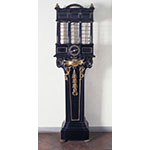The unusual case is of ebonized pearwood, with gilt ornamentation, curlicues, and edges. The pedestal holds an eight-pillared loggia enclosing a light gilt brass structure consisting of curved-line sections imitating three helical spires. Just below the pillars, in a square at the center, is the dial with a silvered hour circle engraved with Roman hour numerals, quarter-hours, and half-hours. The winding hole is above. In 1797, glass panels were fitted to protect the curved brass structure. The machine is housed inside the case level with the dial. It is driven by a weight with rope, a drum, and a train comprising three iron wheels regulated by two brass flywheels. The train is arranged horizontally between two narrow iron plates. The regulation system consists of a small ball (originally, one assumes, of lead or gilt silver), which is dropped from the top of the case and travels down the curved path formed by the thin brass strip with siderails between the pillars of the loggia. The ball then falls into the launch tube and its weight releases the catapult mechanism. It is thus projected upward into the special hole at the top of the case. From there, the ball bounces onto an inclined plane that takes it to the opening at the top of the curved path. There it begins a new descent. Meanwhile, the clock movement reloads the launch mechanism. Each cycle lasts about 30 seconds. The exact duration depends on the ball's specific weight and the tilt of the brass strip.
This clock is described in the 1692 inventory of the Medici Wardrobe (preserved at the Archivio di Stato in Florence) as a "...clock or instrument called perpetual motion..." Inside the pedestal is the inscription "Rassettato tutto nel 1797 a di 2 7mbre Sud.o Il legname da Pasquale Bassetti. Il meccanismo da Fe. Gori" ["All repaired on this day, September 2, 1797, the carpentry by Pasquale Bassetti, the mechanism by Fe[lice] Gori"]. The name "perpetual motion" originates in the seventeenth-century vogue for such contrivances.










